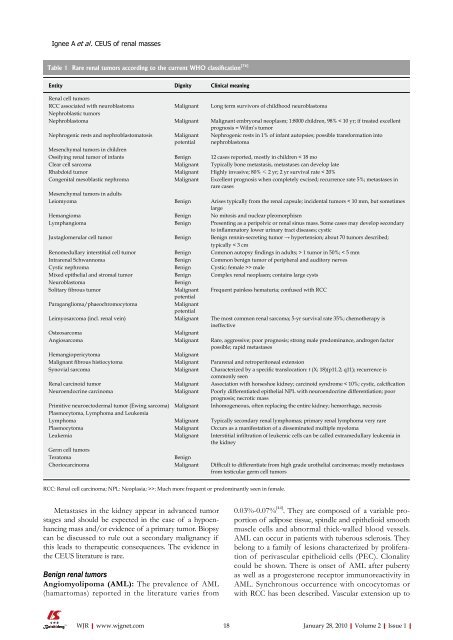World Journal of Radiology - World Journal of Gastroenterology
World Journal of Radiology - World Journal of Gastroenterology
World Journal of Radiology - World Journal of Gastroenterology
Create successful ePaper yourself
Turn your PDF publications into a flip-book with our unique Google optimized e-Paper software.
Ignee A et al . CEUS <strong>of</strong> renal masses<br />
Table 1 Rare renal tumors according to the current WHO classification [76]<br />
Entity Dignity Clinical meaning<br />
Renal cell tumors<br />
RCC associated with neuroblastoma Malignant Long term survivors <strong>of</strong> childhood neuroblastoma<br />
Nephroblastic tumors<br />
Nephroblastoma Malignant Malignant embryonal neoplasm; 1:8000 children, 98% < 10 yr; if treated excellent<br />
prognosis = Wilm’s tumor<br />
Nephrogenic rests and nephroblastomatosis Malignant<br />
potential<br />
Metastases in the kidney appear in advanced tumor<br />
stages and should be expected in the case <strong>of</strong> a hypoenhancing<br />
mass and/or evidence <strong>of</strong> a primary tumor. Biopsy<br />
can be discussed to rule out a secondary malignancy if<br />
this leads to therapeutic consequences. The evidence in<br />
the CEUS literature is rare.<br />
Benign renal tumors<br />
Angiomyolipoma (AML): The prevalence <strong>of</strong> AML<br />
(hamartomas) reported in the literature varies from<br />
WJR|www.wjgnet.com<br />
Nephrogenic rests in 1% <strong>of</strong> infant autopsies; possible transformation into<br />
nephroblastoma<br />
Mesenchymal tumors in children<br />
Ossifying renal tumor <strong>of</strong> infants Benign 12 cases reported, mostly in children < 18 mo<br />
Clear cell sarcoma Malignant Typically bone metastasis, metastases can develop late<br />
Rhabdoid tumor Malignant Highly invasive; 80% ≤ 2 yr; 2 yr survival rate < 20%<br />
Congenital mesoblastic nephroma<br />
Mesenchymal tumors in adults<br />
Malignant Excellent prognosis when completely excised; recurrence rate 5%; metastases in<br />
rare cases<br />
Leiomyoma Benign Arises typically from the renal capsule; incidental tumors < 10 mm, but sometimes<br />
large<br />
Hemangioma Benign No mitosis and nuclear pleomorphism<br />
Lymphangioma Benign Presenting as a peripelvic or renal sinus mass. Some cases may develop secondary<br />
to inflammatory lower urinary tract diseases; cystic<br />
Juxtaglomerular cell tumor Benign Benign rennin-secreting tumor → hypertension; about 70 tumors described;<br />
typically < 3 cm<br />
Renomedullary interstitial cell tumor Benign Common autopsy findings in adults; > 1 tumor in 50%; < 5 mm<br />
Intrarenal Schwannoma Benign Common benign tumor <strong>of</strong> peripheral and auditory nerves<br />
Cystic nephroma Benign Cystic; female >> male<br />
Mixed epithelial and stromal tumor Benign Complex renal neoplasm; contains large cysts<br />
Neuroblastoma Benign<br />
Solitary fibrous tumor Malignant<br />
potential<br />
Frequent painless hematuria; confused with RCC<br />
Paraganglioma/phaeochromocytoma Malignant<br />
potential<br />
Leimyosarcoma (incl. renal vein) Malignant The most common renal sarcoma; 5-yr survival rate 35%; chemotherapy is<br />
ineffective<br />
Osteosarcoma Malignant<br />
Angiosarcoma Malignant Rare, aggressive; poor prognosis; strong male predominance, androgen factor<br />
possible; rapid metastases<br />
Hemangiopericytoma Malignant<br />
Malignant fibrous histiocytoma Malignant Pararenal and retroperitoneal extension<br />
Synovial sarcoma Malignant Characterized by a specific translocation: t (X; 18)(p11.2; q11); recurrence is<br />
commonly seen<br />
Renal carcinoid tumor Malignant Association with horseshoe kidney; carcinoid syndrome < 10%; cystic, calcification<br />
Neuroendocrine carcinoma Malignant Poorly differentiated epithelial NPL with neuroendocrine differentiation; poor<br />
prognosis; necrotic mass<br />
Primitive neuroectodermal tumor (Ewing sarcoma)<br />
Plasmocytoma, Lymphoma and Leukemia<br />
Malignant Inhomogeneous, <strong>of</strong>ten replacing the entire kidney; hemorrhage, necrosis<br />
Lymphoma Malignant Typically secondary renal lymphomas; primary renal lymphoma very rare<br />
Plasmocytoma Malignant Occurs as a manifestation <strong>of</strong> a disseminated multiple myeloma<br />
Leukemia<br />
Germ cell tumors<br />
Malignant Interstitial infiltration <strong>of</strong> leukemic cells can be called extramedullary leukemia in<br />
the kidney<br />
Teratoma Benign<br />
Choriocarcinoma Malignant Difficult to differentiate from high grade urothelial carcinomas; mostly metastases<br />
from testicular germ cell tumors<br />
RCC: Renal cell carcinoma; NPL: Neoplasia; >>: Much more frequent or predominantly seen in female.<br />
0.03%-0.07% [44] . They are composed <strong>of</strong> a variable proportion<br />
<strong>of</strong> adipose tissue, spindle and epithelioid smooth<br />
muscle cells and abnormal thick-walled blood vessels.<br />
AML can occur in patients with tuberous sclerosis. They<br />
belong to a family <strong>of</strong> lesions characterized by proliferation<br />
<strong>of</strong> perivascular epithelioid cells (PEC). Clonality<br />
could be shown. There is onset <strong>of</strong> AML after puberty<br />
as well as a progesterone receptor immunoreactivity in<br />
AML. Synchronous occurrence with oncocytomas or<br />
with RCC has been described. Vascular extension up to<br />
18 January 28, 2010|Volume 2|Issue 1|

















